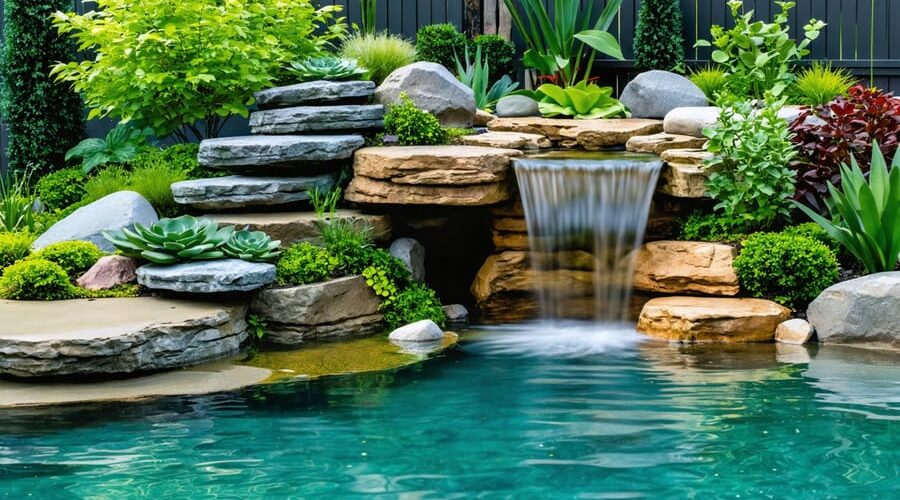
Transform Your Pond into a Living Masterpiece with Expert Aquascaping
Imagine your backyard pond as a living canvas where nature and artistry merge. Transform your pond into living art through thoughtful aquascaping – the art of creating underwater landscapes that captivate both above and below the surface. Just as a painter uses color and texture, pond aquascaping employs carefully selected rocks, plants, and water features to craft a harmonious ecosystem that evolves with each season.
Beyond mere decoration, successful pond aquascaping balances visual appeal with ecological function. Strategic placement of aquatic plants provides natural filtration while creating stunning focal points. Varying depths and shelves support diverse plant life, while expertly positioned rocks create natural-looking transitions and vital hiding spots for pond inhabitants. Whether you’re designing a meditative Zen-inspired water garden or a vibrant ecosystem teeming with life, mastering the principles of aquascaping transforms ordinary water features into extraordinary aquatic sanctuaries.
This dynamic approach to pond design doesn’t just enhance your outdoor space – it creates a living, breathing ecosystem that brings joy year after year. By understanding the fundamental elements of aquascaping, you’ll learn to craft water features that not only look beautiful but also sustain themselves through natural biological processes.
The Foundations of Pond Aquascaping
Design Principles and Natural Flow
Creating a visually appealing pond starts with understanding fundamental design principles that mirror nature’s own patterns. The key is to establish a clear focal point that draws the eye and guides viewers through your aquascape. This could be a striking boulder, a decorative waterfall, or a collection of carefully placed aquatic plants.
The golden ratio, a mathematical principle found throughout nature, plays a crucial role in achieving balance. Apply this by dividing your pond into thirds both horizontally and vertically, placing key elements along these lines or at their intersections. This natural proportion creates a sense of harmony that’s pleasing to the eye, similar to what you might see in various cultural pond designs.
When creating water features, mimic natural water flow patterns. Position rocks and stones to direct water movement in gentle curves rather than straight lines. Layer different-sized rocks, with larger ones at the bottom and smaller ones on top, just as you’d find in a natural stream bed. Remember to vary the depth of your pond, creating shallow margins that gradually slope to deeper areas.
Consider viewing angles from different positions in your garden, including from inside your home. This helps ensure your pond looks attractive from multiple perspectives and integrates seamlessly with your overall landscape design.
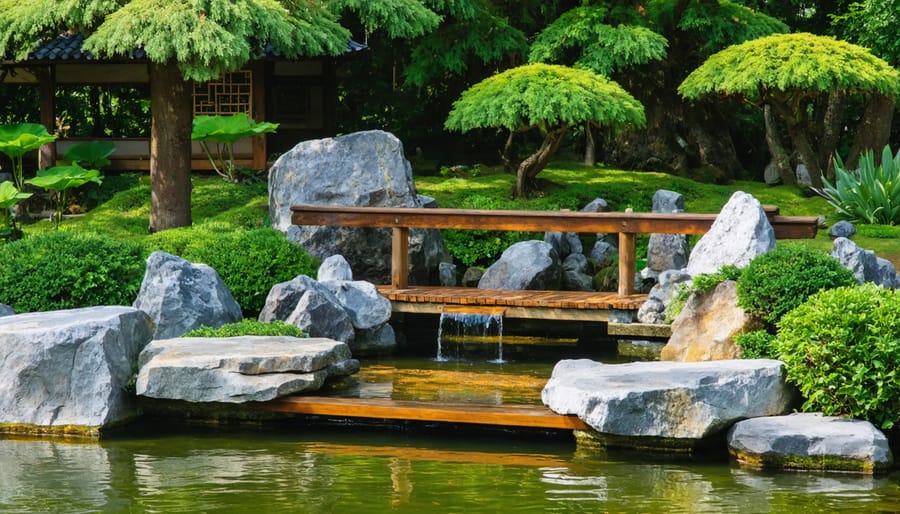
Essential Materials and Hardscaping Elements
The foundation of any stunning pond aquascape lies in its hardscaping elements. Start by using local materials like rocks and stones of varying sizes to create a natural-looking edge around your pond. Choose weathered rocks with interesting textures and shapes that complement your garden’s existing landscape.
Driftwood adds character and creates essential hiding spots for fish while providing surfaces for beneficial bacteria to colonize. Look for hardwood pieces that have been properly cured to prevent water discoloration. Before placing driftwood, soak it in a separate container until it becomes waterlogged to ensure it won’t float.
Consider incorporating slate or flat stones to create shelves and terraces within your pond. These levels not only add visual interest but also provide different planting zones for aquatic vegetation. For a cohesive look, arrange larger rocks at the bottom and graduate to smaller ones as you work your way up.
Don’t forget about substrate! A mixture of different-sized gravels creates a natural-looking bottom that’s perfect for beneficial bacteria and rooting plants. Layer coarser materials at the bottom and finer grades on top for the best results. Remember to rinse all materials thoroughly before adding them to your pond to prevent cloudy water and maintain water quality.
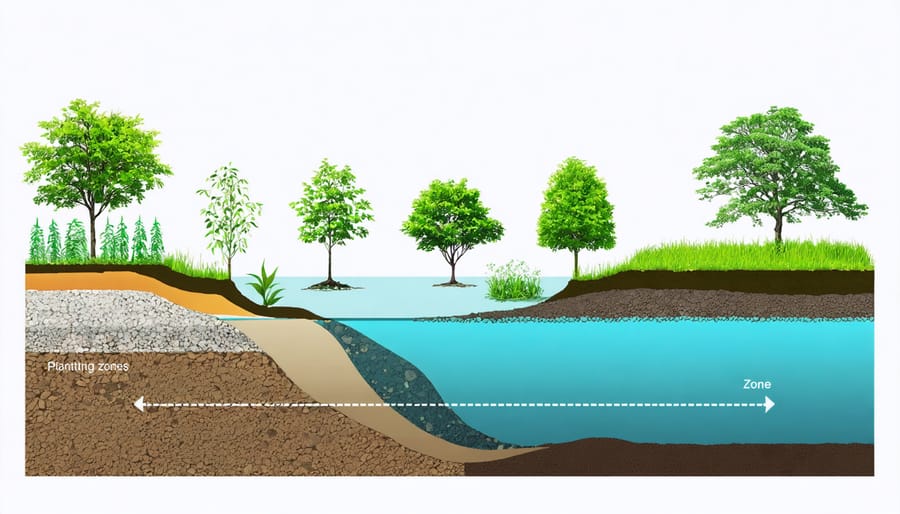
Plant Selection and Placement
Marginal Plants and Edge Design
The transition between your pond and the surrounding landscape is crucial for creating a natural, seamless look. Marginal plants play a vital role in this transition, growing in shallow water or moist soil around the pond’s edges. These plants not only soften the pond’s borders but also provide essential habitat for wildlife and help filter the water.
Start by creating different planting depths around your pond’s edge, from just below water level to slightly above it. This variety allows you to use a diverse range of plants, creating layers of texture and color. Popular marginal plants include iris, rushes, and sedges for vertical interest, while creeping Jenny and marsh marigolds provide beautiful ground cover.
When designing your pond’s edge, incorporate rocks and gravel of varying sizes to create natural-looking transitions. Place larger rocks strategically to hide pond liner edges and create small pools where marginal plants can thrive. Consider adding shallow shelves or bog gardens around the pond’s perimeter, which will allow you to expand your plant selection and create more natural-looking edges.
Remember to maintain proper spacing between plants, allowing room for growth while ensuring adequate coverage. Group plants in odd numbers for a more natural appearance, and consider their mature sizes when planning. For added interest, include some plants that trail over rocks or cascade toward the water, creating a soft, natural flow between land and water.
Submerged and Floating Plants
Creating the perfect balance between submerged and floating plants is crucial for a healthy and visually appealing pond. Underwater plants like Anacharis and Hornwort not only provide shelter for fish but also help maintain water clarity by absorbing excess nutrients. Aim to cover about 50-60% of your pond bottom with submerged plants, arranging them in groups to create natural-looking underwater landscapes.
Floating plants like Water Lilies and Water Hyacinths add beautiful surface interest while providing essential shade. This shade helps control algae growth and keeps the water temperature stable for aquatic life. However, be careful not to let floating plants cover more than 60-70% of your pond’s surface, as too much coverage can limit oxygen exchange and block light from reaching submerged plants.
For the best results, combine different plant types at varying depths. Place oxygenating plants in the deepest areas, marginal plants along the edges, and distribute floating plants across the surface. This layered approach creates a natural ecosystem while offering stunning visual appeal.
Remember to maintain a seasonal balance. Some floating plants grow vigorously in summer, so you’ll need to thin them regularly. In contrast, many submerged plants go dormant in winter, so plan your plant selection to ensure year-round coverage. Start with a few varieties and adjust based on how they perform in your specific pond conditions.
Seasonal Planning for Year-Round Appeal
A well-designed pond should captivate throughout the year, and careful seasonal planning is key to achieving this goal. Start by selecting plants with different blooming periods to ensure continuous color. Spring can showcase early-blooming water lilies and iris, while summer brings lotus flowers and tropical marginals into their full glory.
For fall interest, incorporate plants with striking foliage colors like Japanese maples near the pond’s edge, and consider ornamental grasses that provide movement and texture even as temperatures drop. Hardy rushes and sedges maintain their green appearance well into winter, providing structure when other plants go dormant.
Consider incorporating permanent features like decorative rocks, driftwood, and artistic hardscaping that look stunning year-round, especially when dusted with snow or frost. Strategic lighting can transform your pond after dark and becomes particularly important during shorter winter days.
Don’t forget about fish selection – choosing varieties with different coloration can add visual interest even in cooler months when plant life is minimal. Koi and golden orfe are particularly striking against winter’s muted palette.
Layer your plantings in terms of both height and bloom time. Place tall background plants that provide winter interest behind medium-height summer bloomers, with low-growing spring plants in the foreground. This creates depth and ensures there’s always something catching the eye, regardless of the season.
Creating Depth and Perspective
Layer Building Techniques
Creating depth in your pond’s design is like painting a landscape – you want to build layers that draw the eye from the foreground to the background. Start by placing larger rocks and boulders at the pond’s edge, creating natural-looking transitions between land and water. These serve as your foundation layer and help anchor the design.
In the middle ground, arrange medium-sized stones and aquatic plants of varying heights. Consider using plants like marsh marigolds or iris at the margins, then graduate to taller species like cattails or rushes behind them. This creates a natural flow and adds visual interest at different levels.
For the background, incorporate tall architectural plants and possibly a focal point like a waterfall or decorative feature. Remember to leave open spaces between your layers – these “negative spaces” are crucial for creating depth and allowing viewers to appreciate each element individually.
When placing underwater elements, follow the same principle. Position larger plants and rocks toward the back, with smaller specimens in front. This underwater layering not only looks natural but also provides hiding spots for pond inhabitants. For added depth perception, use darker-colored elements in the background and lighter ones in the foreground.
Keep maintenance in mind as you build your layers. Ensure you can easily reach plants for pruning and leave enough space between elements for proper water circulation.
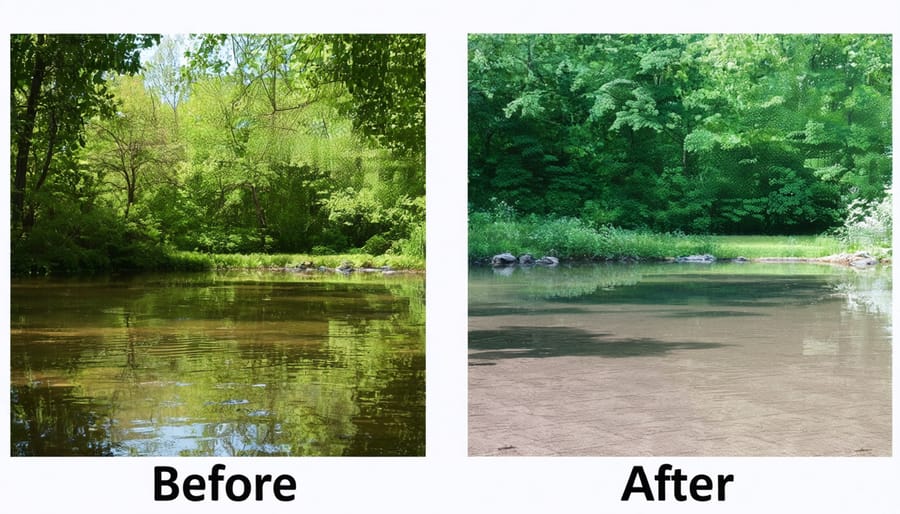
Optical Illusions in Pond Design
Creating visual depth and space in your pond design is easier than you might think, thanks to some clever optical illusions. By strategically placing rocks and plants, you can make your pond appear larger and more natural, even in a limited space.
One of the most effective tricks is using forced perspective. Place larger rocks and plants in the foreground, gradually decreasing their size as they move toward the back of the pond. This creates an illusion of distance and makes your pond appear deeper and more expansive.
Color plays a crucial role too. Dark-colored stones at the bottom of the pond create the impression of depth, while lighter-colored rocks along the edges help define the pond’s shape. Consider using black pond liner rather than blue, as it creates better reflections and enhances the feeling of depth.
Another useful technique is the strategic placement of focal points. Installing a waterfall or striking piece of driftwood slightly off-center draws the eye and creates visual movement. This asymmetrical design approach feels more natural and helps break up the space effectively.
Don’t forget about the power of reflection! A still water surface acts like a mirror, doubling the visual impact of your design. Position taller plants or decorative elements where their reflection will enhance the overall composition. By incorporating these optical illusions, you can transform even the smallest pond into a seemingly boundless water feature.
Balancing Aesthetics with Functionality
Filtration and Water Flow Integration
One of the biggest challenges in pond aquascaping is integrating filtration systems and water flow equipment without compromising the natural aesthetic. The key to creating the perfect water symphony lies in clever concealment while maintaining optimal functionality.
Start by positioning your pump and filter in a strategic location where they can be easily hidden behind rocks or aquatic plants. Large boulders can create natural-looking caves that house mechanical equipment, while tall marginal plants like iris or cattails can form living screens. Consider building a small waterfall feature that not only masks equipment but also adds beautiful movement and sound to your pond.
When installing piping, bury it beneath the substrate or tuck it behind carefully placed rocks. Black tubing blends better with shadows and is less noticeable than white or clear alternatives. For skimmers and filter boxes that must remain accessible, create decorative covers using artificial rock formations or incorporate them into raised garden beds surrounding the pond.
Remember that proper water circulation is essential for pond health, so don’t sacrifice function for aesthetics. Position your equipment to create gentle currents that reach all areas of the pond. This helps prevent stagnant zones and maintains even water quality. Consider using multiple smaller pumps instead of one large unit – they’re easier to hide and provide better circulation control.
For electrical cables, use protective conduit and route them through planted areas where they’ll be naturally concealed. Consider installing an underwater LED lighting system at the same time, as you can hide both sets of cables together. This forward thinking will save you from disturbing your aquascape later.
By carefully planning your equipment placement and using natural elements as camouflage, you can maintain an efficient filtration system while preserving the wild, untamed beauty of your pond ecosystem.
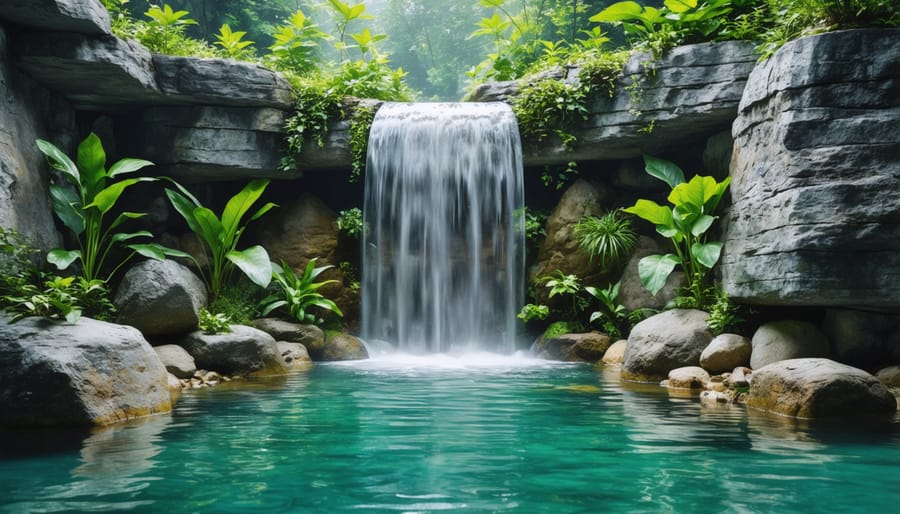
Fish Habitat Considerations
When designing your pond’s aquascape, creating a healthy habitat for fish should be a top priority alongside aesthetic considerations. Fish need more than just clean water – they require specific features that mimic their natural environment and provide safety, comfort, and enrichment.
Start by incorporating various depths in your pond design. Most pond fish prefer having both shallow and deep areas, with deeper sections (at least 4 feet) serving as essential refuge zones during extreme weather conditions. These depth variations also create interesting visual layers in your aquascape.
Plants play a crucial role in fish habitat. Include a mix of submerged, floating, and marginal plants. Underwater plants like hornwort provide oxygen and shelter, while floating plants like water lilies offer shade and protection from predators. Aim to cover about 60% of your pond’s surface with plants to create a self-sustaining pond system.
Structure is equally important. Incorporate rocks, driftwood, and artificial caves to create hiding spots and territories for your fish. These elements not only add visual interest but also reduce stress in fish by providing safe spaces. Position larger rocks and features to create natural swimming channels, which encourages exercise and natural behavior.
Remember to include gentle slopes rather than steep drops, as this helps fish navigate different water levels safely. Create distinct zones for feeding, resting, and exploring. Shallow shelves near the edges provide perfect spots for smaller fish to warm up and feed, while strategically placed rock formations in deeper areas offer peaceful resting spots.
Avoid overcrowding your pond with too many features – fish need open swimming areas too. Strike a balance between covered and open spaces, typically maintaining a 40:60 ratio of structure to open water. This approach creates an environment that’s both visually appealing and perfectly suited to your aquatic friends’ needs.
Embarking on your pond aquascaping journey is an exciting adventure that combines creativity, nature, and personal expression. As we’ve explored throughout this guide, successful pond aquascaping requires thoughtful planning, careful plant selection, and attention to both aesthetic and ecological principles.
Remember that your aquascaped pond is more than just a water feature – it’s a living ecosystem that brings life and tranquility to your outdoor space. By following the fundamental principles we’ve discussed, from creating depth with different plant heights to maintaining proper water quality, you’ll be well-equipped to create a stunning aquascape that thrives year after year.
Don’t be afraid to experiment with different combinations of plants, rocks, and design elements. Your pond will evolve over time, and that’s part of the beauty of aquascaping. Start small if you’re feeling overwhelmed, and gradually expand your design as you gain confidence and experience.
The most successful pond aquascapes are those that reflect their creator’s personality while respecting nature’s balance. Whether you’re aiming for a zen-inspired minimalist design or a lush, naturalistic paradise, the key is to maintain harmony between the artistic and practical aspects of your pond.
We encourage you to take the first step in your aquascaping journey today. With patience, creativity, and the knowledge you’ve gained, you’ll be able to transform your pond into a captivating underwater landscape that brings joy and serenity to your outdoor space for years to come.
Remember, every great aquascape started with a single plant or stone. The possibilities are endless, and your perfect pond paradise awaits!
